Simple and comforting, this kimchi udon noodle soup recipe blends spicy kimchi with savory dashi broth and smooth udon. A quick, flavorful fusion of Korean and Japanese tastes in 20-minutes!
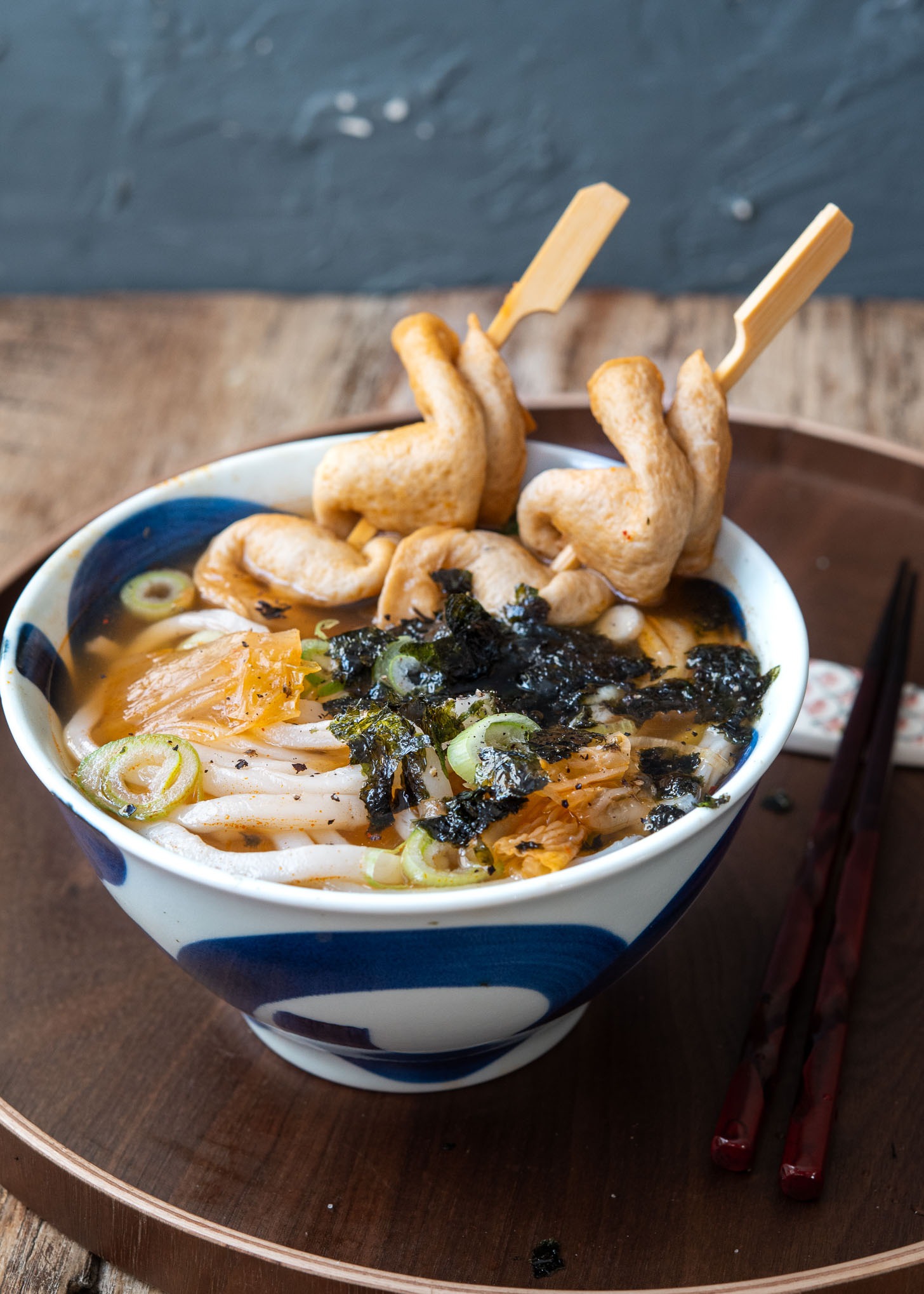

In Korea, udon noodles are a beloved dish, just like they are for me and many others. As you travel along Korea’s highways, you’ll encounter numerous rest stops. These spots are famous for their convenient food stalls, offering a variety of quick meals and snacks.
Among these, kimchi udon noodle soup (김치우동) stands out as a crowd-pleaser. Imagine warming up with a steaming bowl of this delicious noodle soup during a chilly winter road trip. It’s what I like to call ‘comfort in a bowl – kimchi udon soup for the soul’.
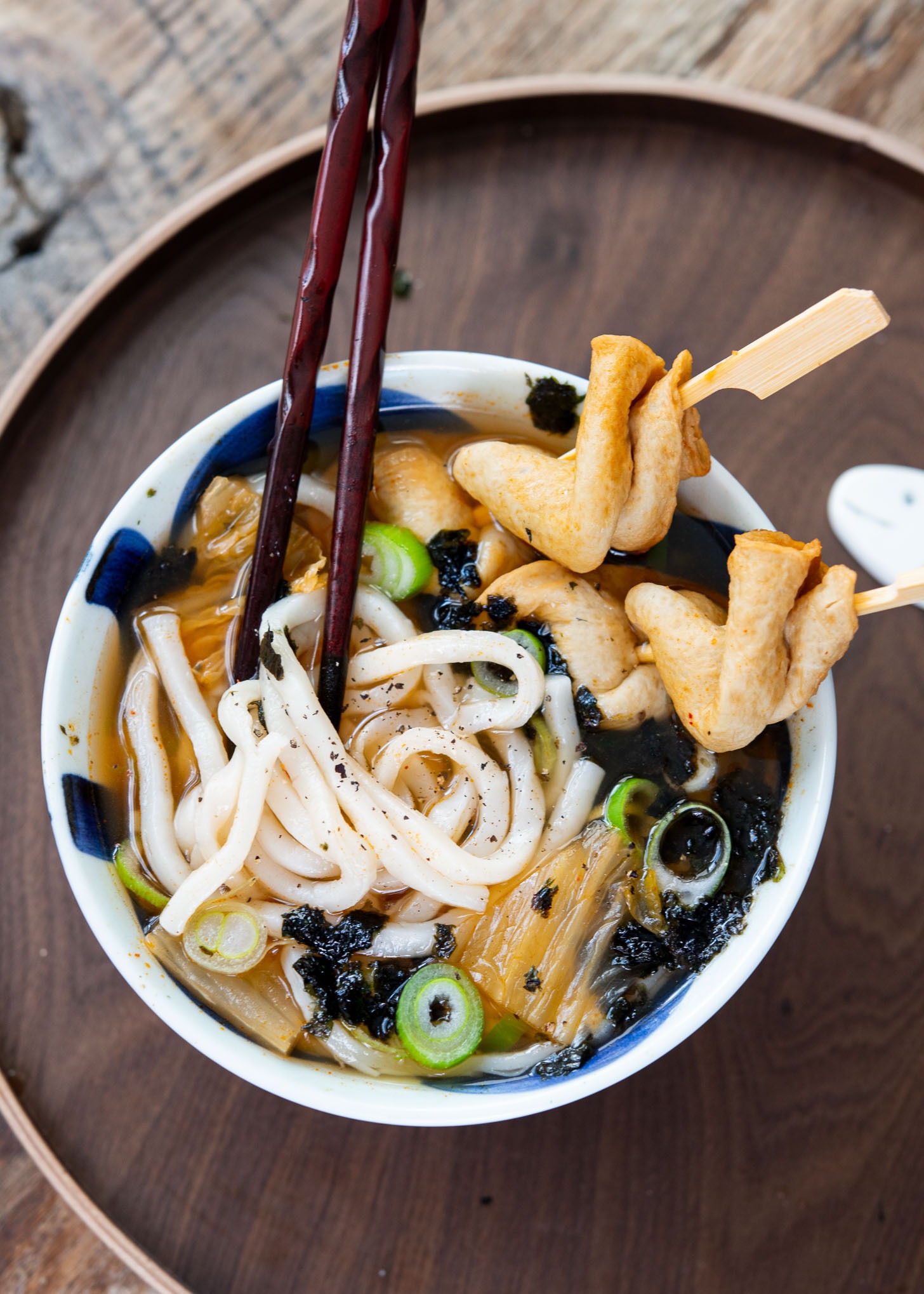

Korean Kimchi in Japanese Dashi Broth
Combining Korean kimchi with Japanese udon in dashi broth results in a deliciously unique fusion dish. The spicy kick of kimchi blends seamlessly with the dashi broth’s subtle, savory notes. This creates a soup base that is both tangy and mildly spicy, offering an exciting twist on traditional udon soup.
This fusion of Korean cuisine with Japanese flavors enriches the soup with a delightful new taste dimension. Kimchi pairs well with udon, making this kimchi udon noodle soup both spicy and comforting.
Perfect for a quick, tasty lunch or a cozy dinner, this easy-to-prepare kimchi udon soup recipe is a flavor-packed must-try for noodle soup lovers. All in 20-minutes or less to make!
Recipe Ingredients and where to find them
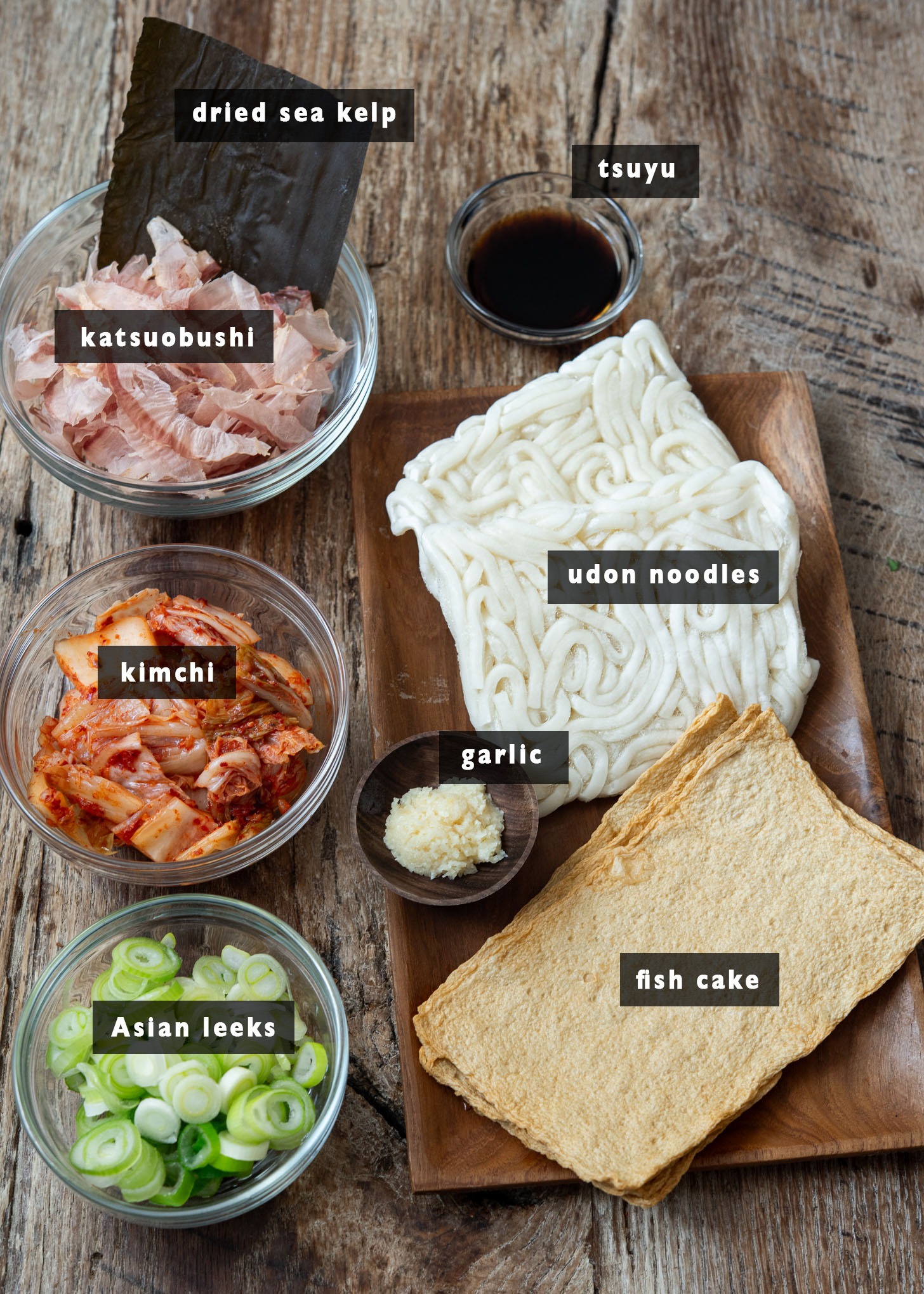

For the Soup Base (Dashi):
- Dried Sea Kelp (Dashima or Kombu): Essential for umami flavor in dashi. It’s sold in large sheets to cut as needed and is available in most Asian stores.
- Katsuobushi: Also known as bonito flakes, these thinly shaved smoked, dried fish is crucial for enhancing dashi’s flavor depth. Find it in Asian or Korean markets. If not available, substitute with dried anchovies.
- Kimchi: Essential for its spicy, tangy flavor. Fermented kimchi, particularly those with a sour taste, works best in this soup as it adds depth and complexity to the flavor profile.
- Available in the refrigerated section of Asian markets or international aisles in supermarkets, chop or slice the kimchi to blend smoothly into the soup.
- Udon noodles: Thick, chewy Japanese wheat noodles, essential for the base of the soup. Available as fresh, dried, or pre-cooked, you can find them in the Asian aisle of supermarkets or in Japanese and Korean stores.
- While fresh udon noodles offer the best texture, frozen Sanuki udon is a convenient, tasty alternative. See my Yaki udon recipe for the use of Sanuki udon noodles.
- Tsuyu: Japnaese noodle soup base with a seasoned soy-based sauce. It boosts the soup’s umami and savory qualities. Available in Asian markets or well-stocked local grocery stores.
- Garlic: Its subtle pungency adds complexity to the broth.
- Asian Leek or Green Onion: Imparts a savory flavor and is also used for garnish.
Additional Ingredients:
- Fish Cake Sheet: A common component in kimchi udon soup, it can be skewered or cut to simmer in the soup, providing a mild, savory fish taste. Available in the freezer section of Korean or Japanese stores. Check out my fish cake soup (eomuk-tang) recipe.
- Dried Seaweed Snack (Gim): Optional for garnish, it’s a frequent topping in Korean noodle soupsadding crunch.
To add protein while offering a different texture, consider replacing the fish cake with fried tofu puffs or a soft-boiled egg.
How to Make Kimchi Udon Noodle Soup
Fish Cake Preparation (optional)
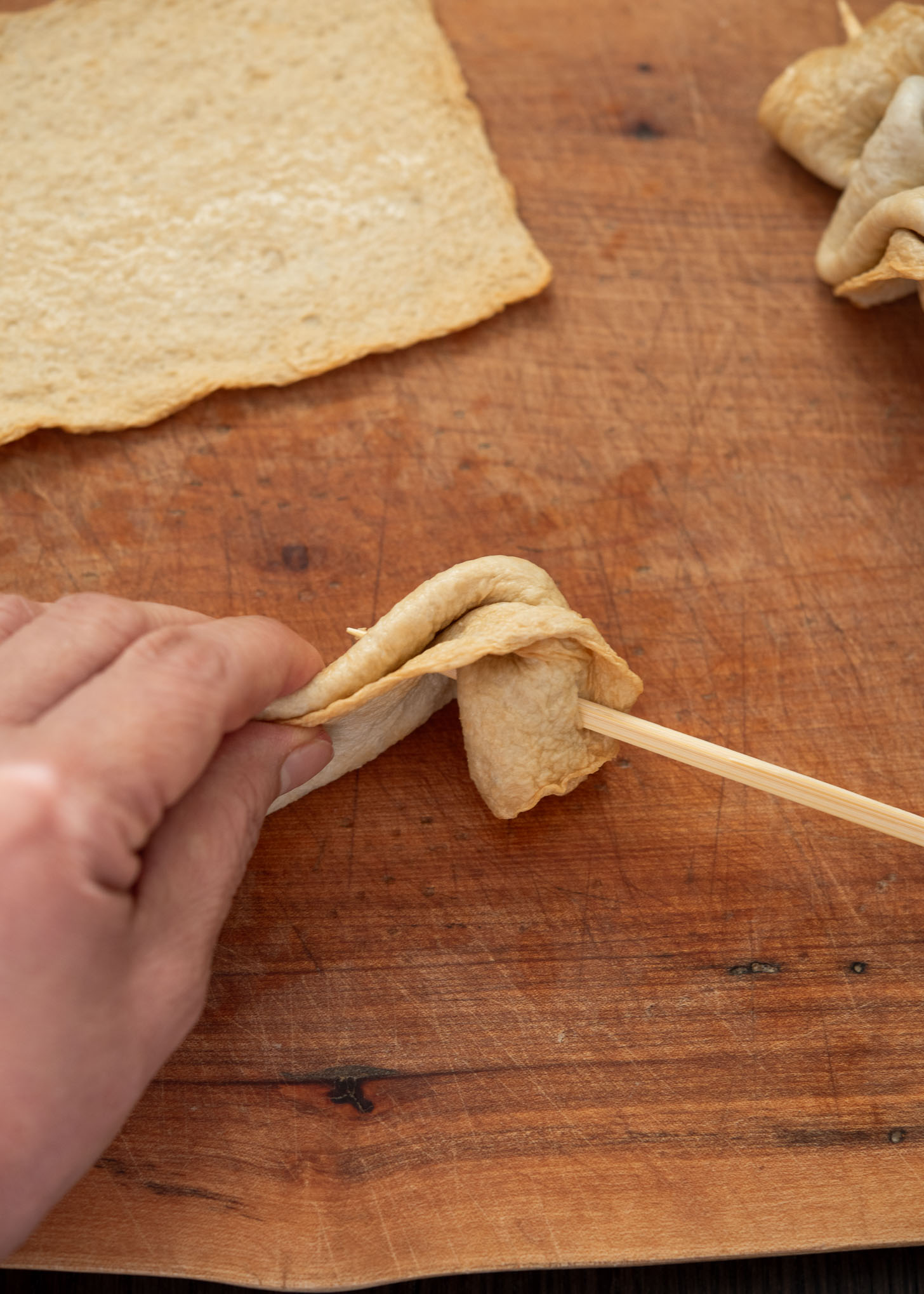

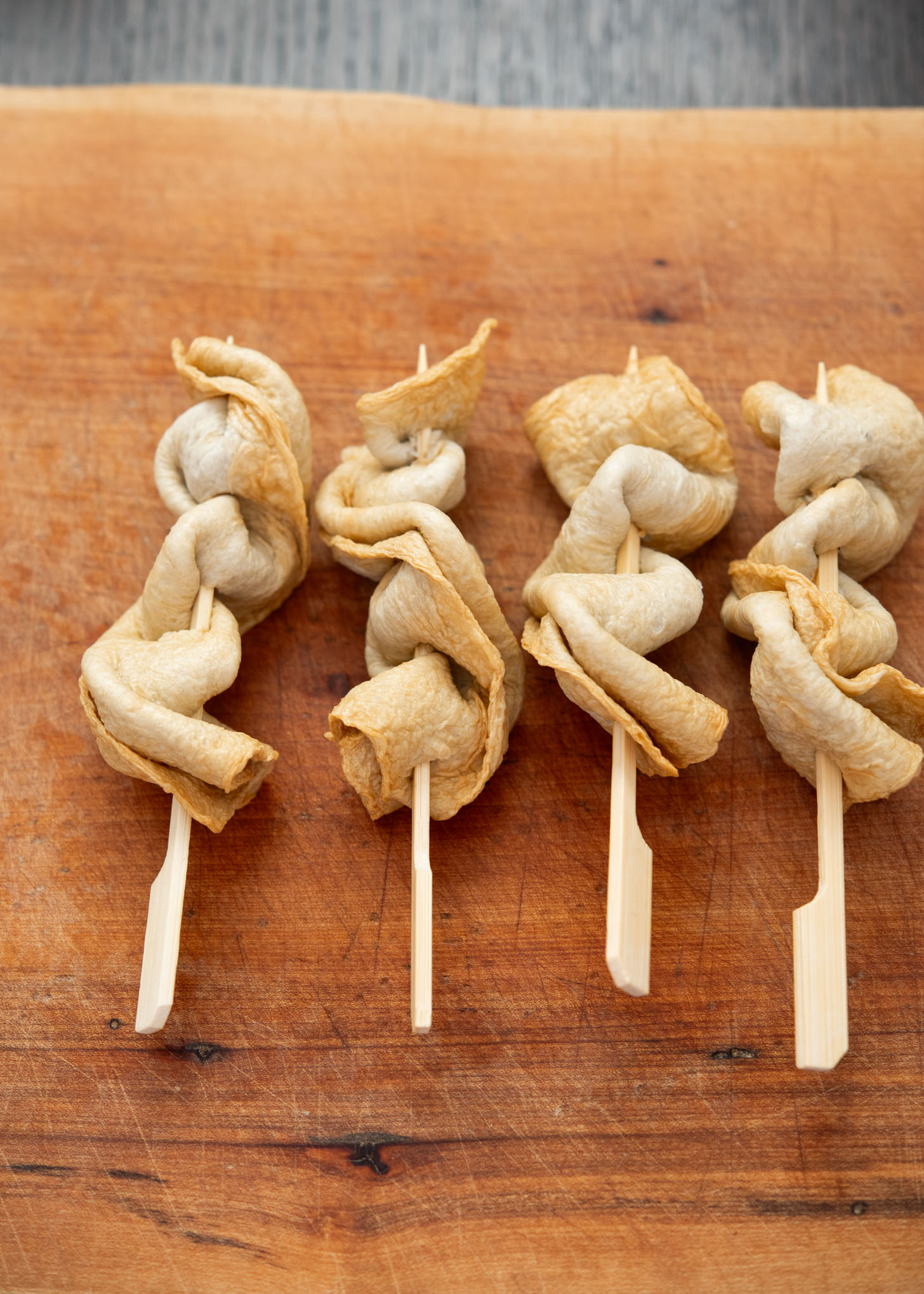

- Fold the fish cake sheet lengthwise into halves or thirds.
- Insert a wooden stick through the top of the folds and twist as you skewer them, about 2-3 times per sheet. Set aside.
Kimchi Dashi Soup Base
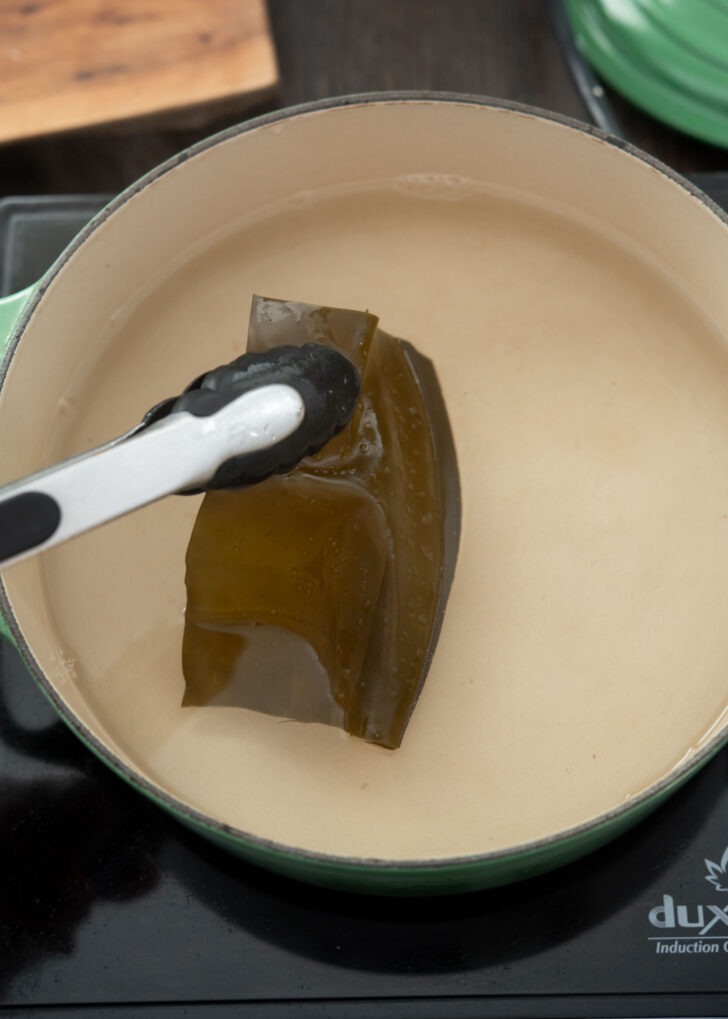

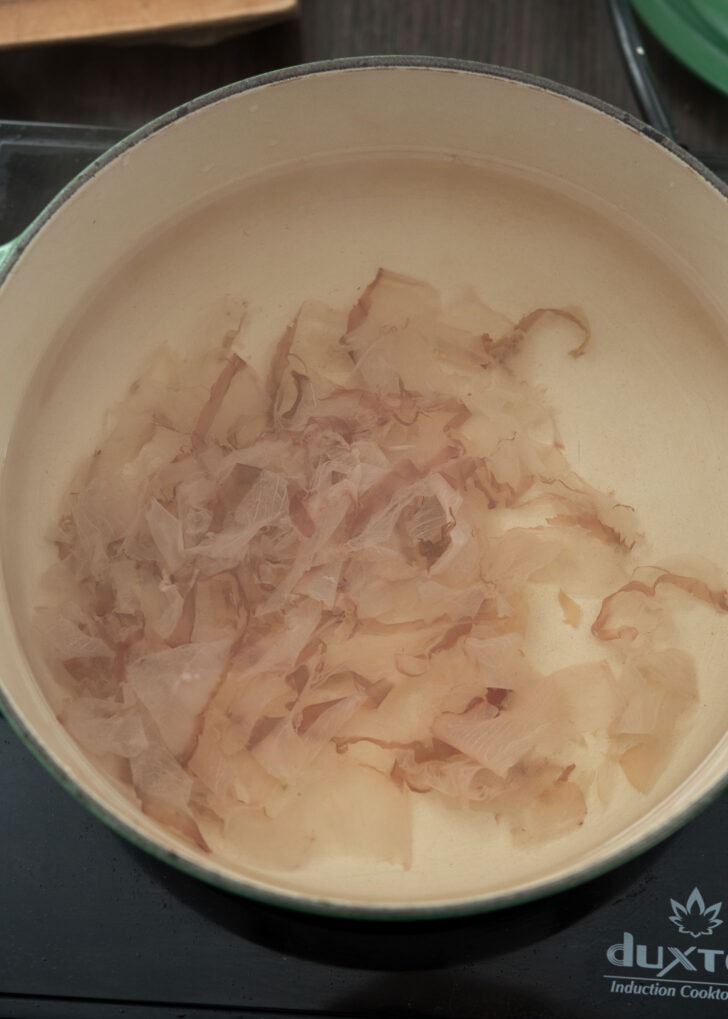

- In a large soup pot, combine a piece of dried sea kelp with 8 cups of water and bring to a boil over medium-high heat. Remove and discard the kelp, then take the pot off the heat.
- Add katsuobushi to the kelp stock, cover with a lid, and let sit for 5 minutes. Strain out the katsuobushi, keeping the stock.
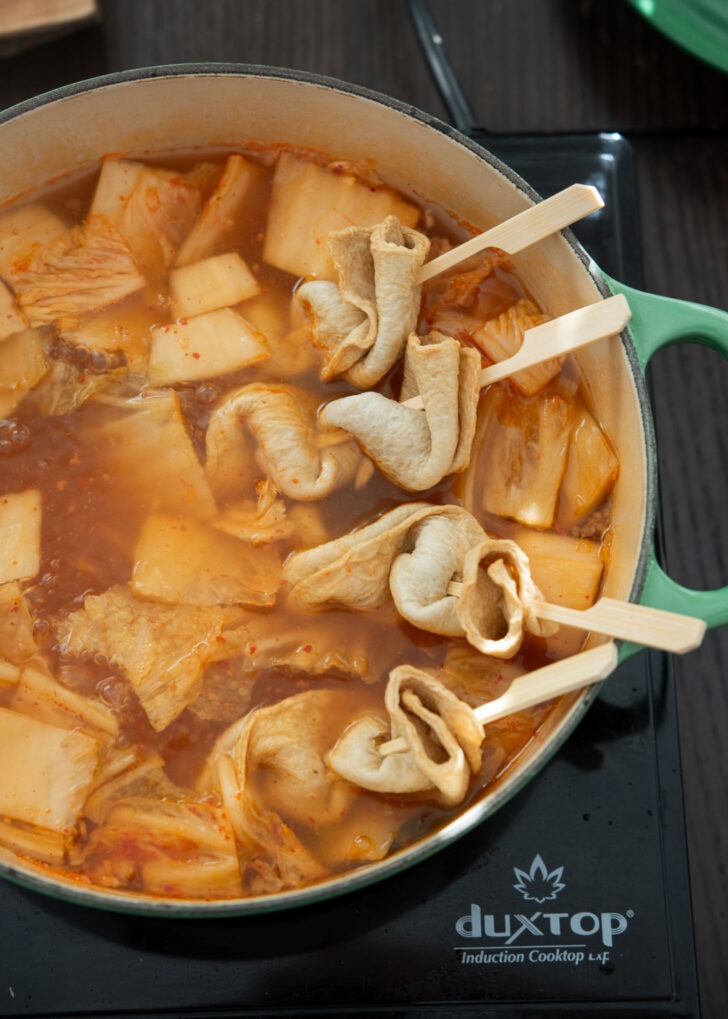

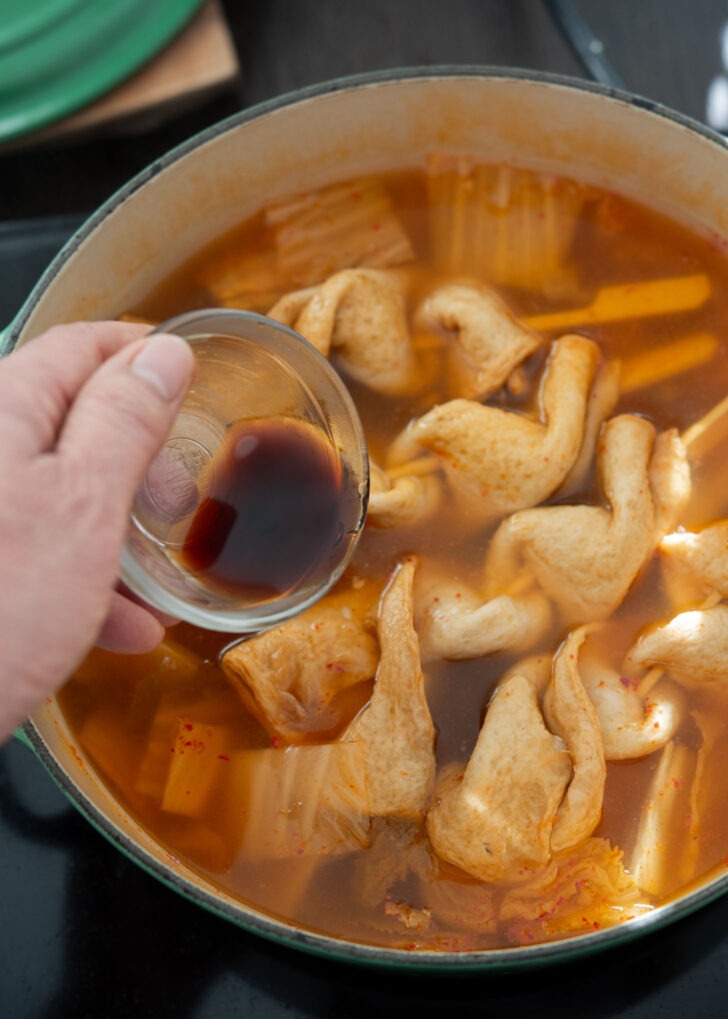

- Add sliced kimchi and kimchi juice to the stock and bring to a boil. Reduce heat and simmer for 5 minutes. Then, add the fish cake and simmer for another 5 minutes.
- Season the soup base with tsuyu, salt, and pepper to taste.
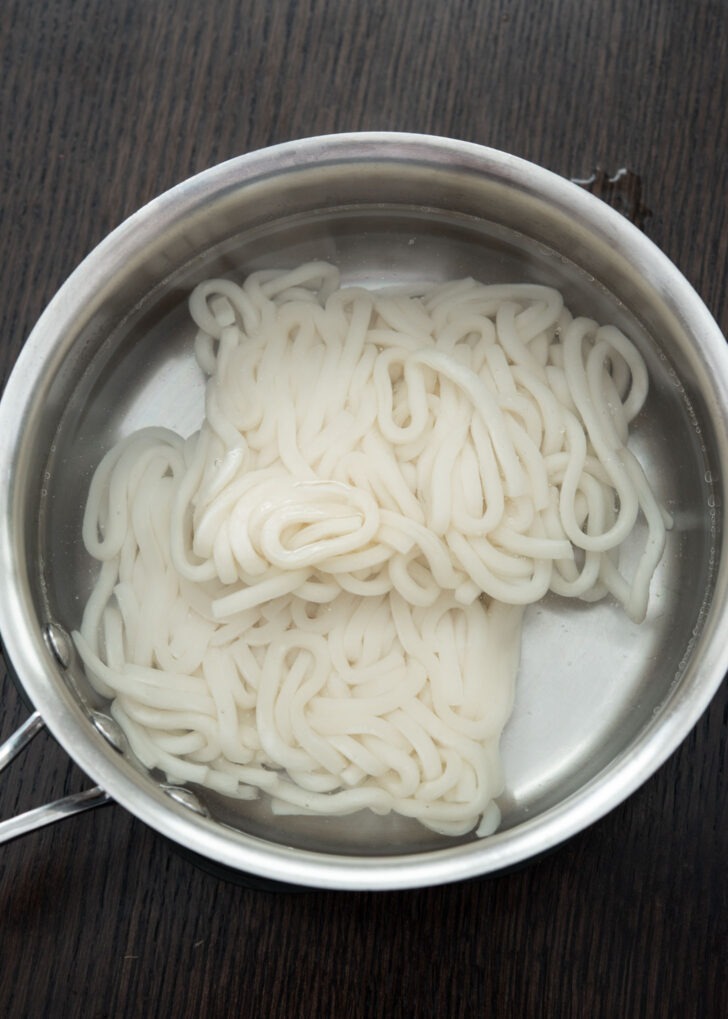

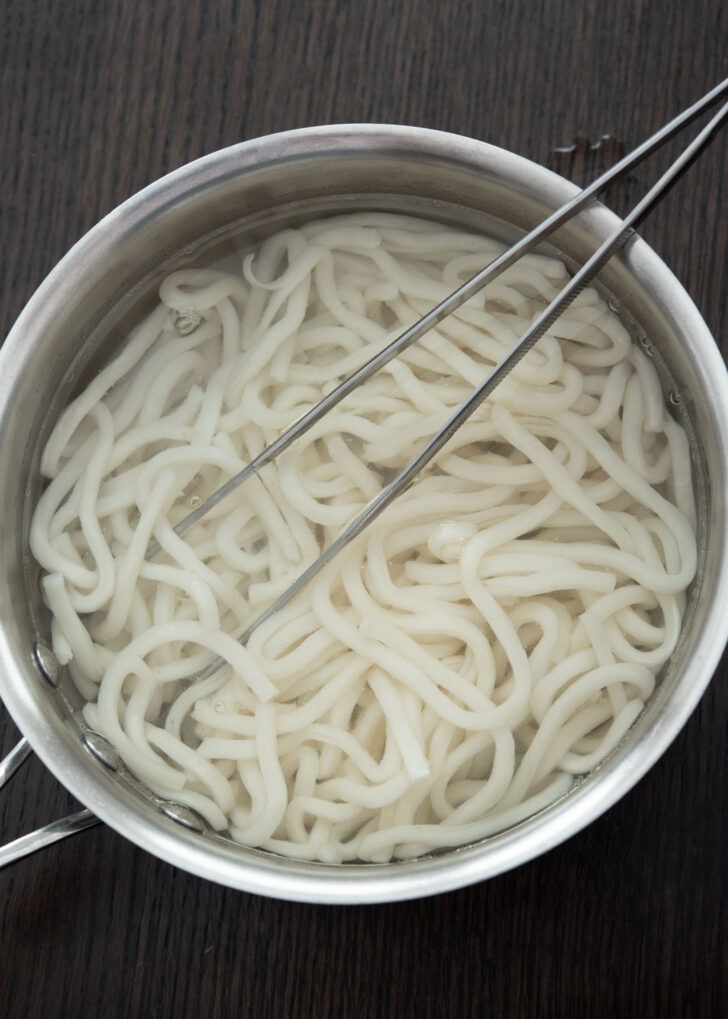

- For Udon Noodles, Boil water in a separate pot (The water should be enough to cover the noodles). Turn off the heat, add frozen udon noodles, and let them soak for 2 minutes.
- Once loosened, gently separate the strands.
Serving Suggestions
Place a portion of noodles in a bowl. Pour the kimchi dashi soup over the noodles, adding fish cake pieces or skewers.
Garnish with thin slices of Asian leek or chopped green onions and crumbled dried seaweed snack. Top with freshly cracked black pepper. Serve hot and enjoy!
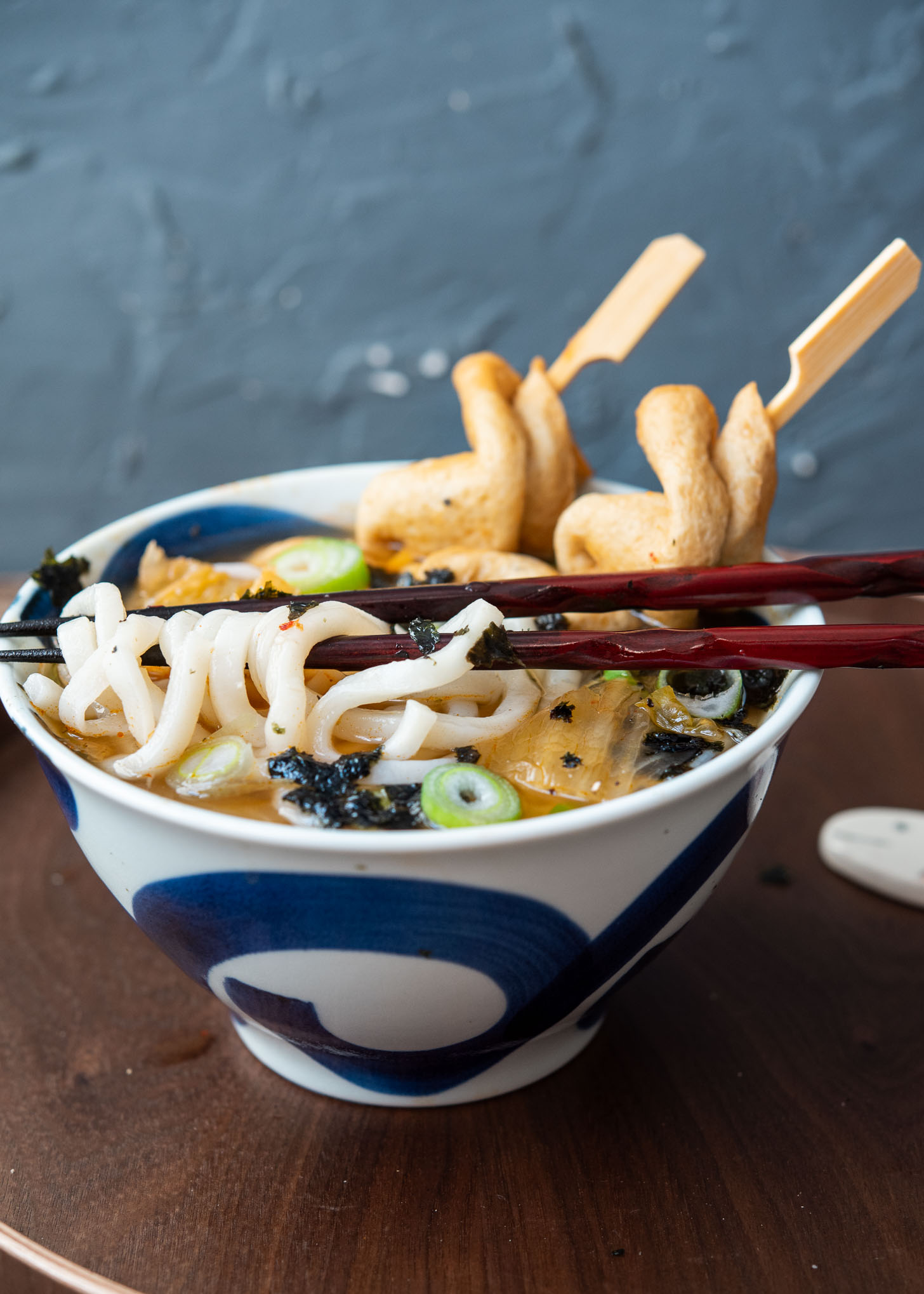

More Noodle Soup Recipes
First posted in Nov 2012, this recipe now has new photos and updates. If you like it, please rate and comment. Subscribe to our newsletter for more great recipes.
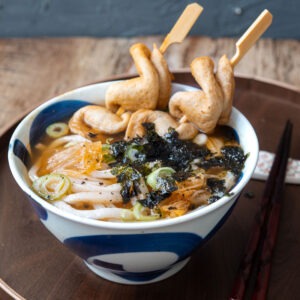

20-Minute Kimchi Udon Noodle Soup
Quick and flavorful, this Kimchi Udon Soup recipe combines spicy kimchi with savory dashi and smooth udon for a perfect Korean-Japanese fusion.
- 6 cups water
- 1 dried sea kelp (dashima), use a large piece
- 2 handful katsuobushi (Japanese bonito flakes), or 8-10 large dried anchovies
- 2/3 cup fermented cabbage kimchi, chopped
- 2 tbsp kimchi juice
- 2 tbsp tsuyu , or soy sauce
- salt and pepper, to taste
- 4 fish cake sheets, skewered or diced
- 2 packages frozen udon noodles
- 1/2 Asian leek , sliced, or 2 green onion chopped
- 1/2 cup crumbled dried seaweed snack, optional
-
To make fish cake skewers: Fold the fish cake sheet lengthwise into halves or thirds. Insert a wooden stick through the top of the folds and twist as you skewer them, about 2-3 times per sheet. Set aside.
-
To make dashi soup base: In a large soup pot, combine a piece of dried sea kelp with 8 cups of water and bring to a boil over medium-high heat. Remove and discard the kelp, then take the pot off the heat. Add katsuobushi to the kelp stock, cover with a lid, and let sit for 5 minutes. Strain out the katsuobushi, keeping the stock.
-
Add sliced kimchi and kimchi juice to the stock and bring to a boil. Reduce heat and simmer for 5 minutes. Then, add the fish cake and simmer for another 5 minutes. Season the soup base with tsuyu, salt, and pepper to taste.
-
For udon Noodles: Boil water in a separate pot (The water should be enough to cover the noodles). Turn off the heat, add frozen udon noodles, and let them soak for 2 minutes. Once loosened, gently separate the strands.
-
To serve: Place a portion of noodles in a bowl. Pour the kimchi dashi soup over the noodles, adding fish cake pieces or skewers. Garnish with thin slices of Asian leek or chopped green onions and crumbled dried seaweed snack. Top with freshly cracked black pepper. Serve hot and enjoy!

